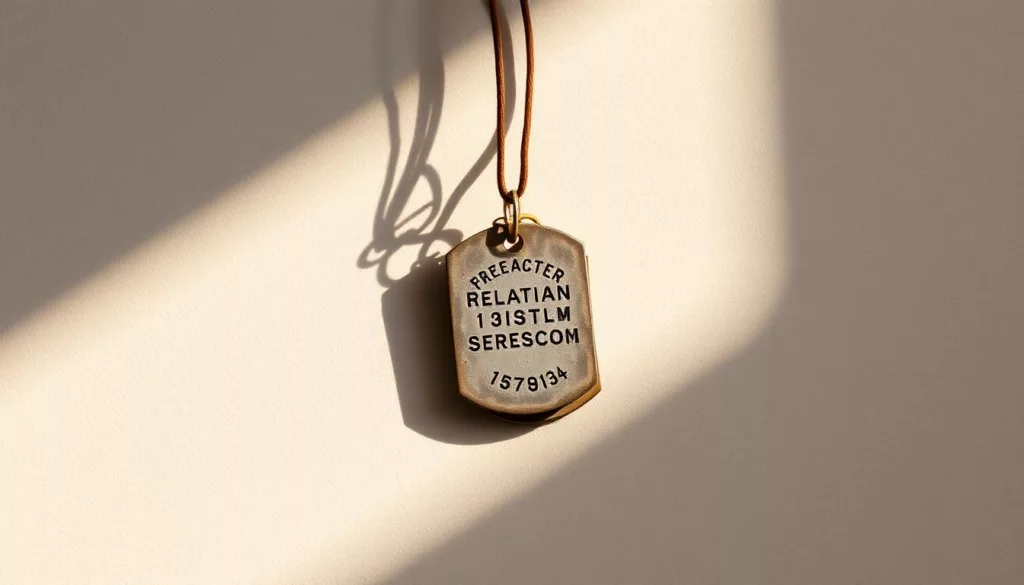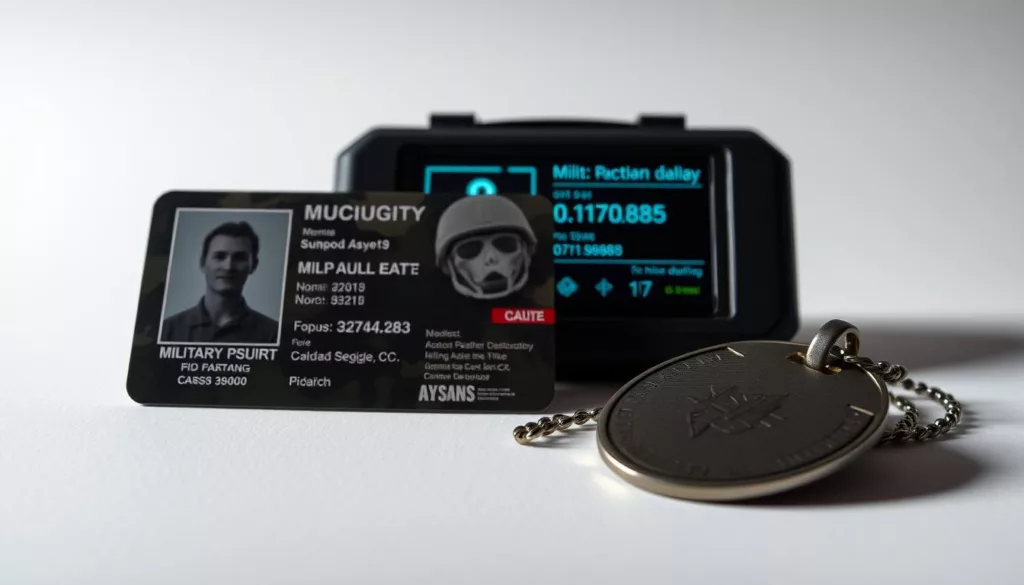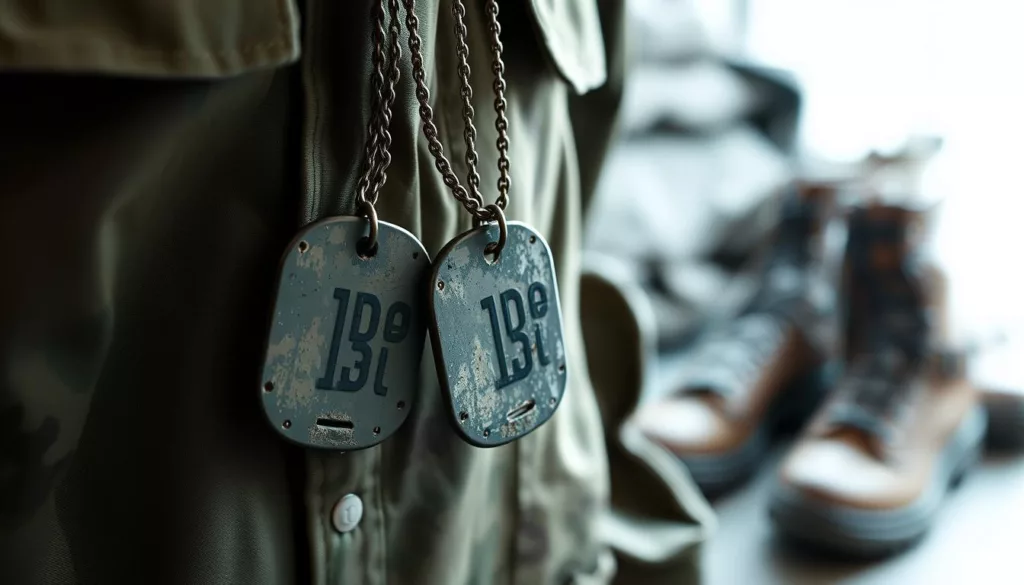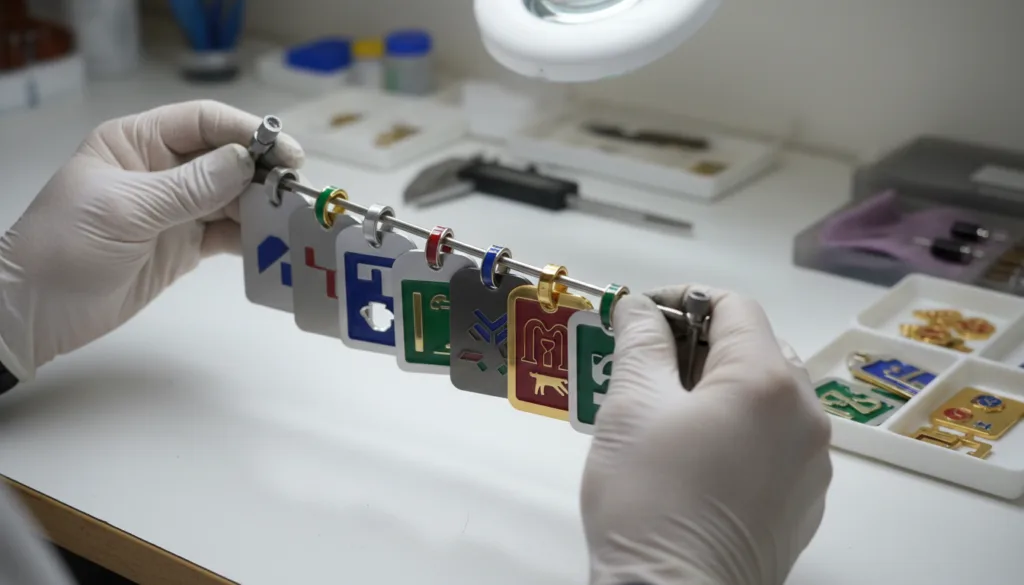The US military still gives out dog tags to its soldiers. This tradition is key for identifying them. Even with new tech, the Department of Defense keeps issuing these tags. They help ensure soldiers are recognized during missions and in combat.
Today, dog tags carry more than just a soldier’s name. They also have medical info and emergency contacts. These tags have changed over the years, but they still hold a special place in military service.
Key Takeaways
- The US military continues to issue dog tags to all service members.
- Modern dog tags provide crucial identification and medical information.
- The design and materials of military dog tags have evolved over time.
- Dog tags remain vital for personal identification during deployments and combat.
- The tradition of soldier identification tags persists across all branches of the military.
Introduction to Military Identification Tags
Military identification tags, also known as dog tags, are crucial for identifying and managing military personnel. These small, durable metal tags are worn around the neck. They have vital information like name, rank, service number, and blood type.
What Are Dog Tags?
Dog tags are made of strong metals like stainless steel. They are designed to last in tough conditions. These tags help quickly identify someone in emergencies, like combat or medical situations. They also carry important medical info to help in injuries or evacuations.
Brief History of Dog Tags
The history of military identification tags began in the American Civil War. Back then, soldiers used makeshift tags for identification. But it wasn’t until World War I that standardized dog tags became common. Since then, dog tags have evolved with military technology and practices.
Importance of Dog Tags
Dog tags are very important in military operations. They help in reporting casualties quickly and respectfully. They also help keep accurate records of military personnel. For soldiers, dog tags are a symbol of their service and dedication.
Current Issuance of Dog Tags in the US Military
The US military has updated how it issues dog tags. This change comes from new tech and rules. Each tag follows strict dog tags issuance standards for quality and trustworthiness.
Regulations and Standards
Today’s military rules are clear about dog tags. They say:
- Material: Must be stainless steel or anodized aluminum for toughness.
- Information: Includes name, Social Security number, blood type, and religious views.
- Format: Info is engraved or stamped clearly and in order.
By following these standards, the military makes sure each soldier gets strong, dependable tags.
Recent Changes and Updates
The military has made some big changes in how it identifies its members. These updates include:
- New engraving methods for tags that last longer and are easier to read.
- Adding QR codes or RFID chips to tags for extra security.
- Better manufacturing to meet green standards.
These recent updates in military identification make dog tags more useful and secure. They keep dog tags a key part of military life.
The military sticks to its rules and keeps improving dog tags. This shows its dedication to reliable, consistent ID for its people.
Do Soldiers Still Get Dog Tags?
In today’s military, dog tags are just as important as they were before. They are key for personal identification in the military, which is vital during deployments. Soldiers still get dog tags, which are essential for identifying them and sharing important information.
Personal Identification During Deployments
During deployments, personal identification in the military relies on dog tags. These tags have important details like the soldier’s name, Social Security Number, blood type, and religious beliefs. This information is crucial for care if a soldier is injured or killed, and for notifying their family.
Personalization and Standardization
Even though dog tags follow strict rules, there’s room for customization of dog tags. Soldiers can add personal touches, like extra details or specific finishes. This mix of personalization and standardization requirements makes sure each tag meets rules while showing individuality.
Dog Tags in Different Branches of the Military
Each branch of the US military has its own dog tags. These tags show the unique identity and needs of each branch. We’ll look at the Army, Navy, and Air Force dog tags.
Army Dog Tags
Army dog tags are tough and carry vital soldier info. They usually have:
- Soldier’s Name
- Social Security Number
- Blood Type
- Religious Preference
Army dog tags help identify soldiers in combat. They also ensure soldiers get the right medical care.
Navy Dog Tags
Navy dog tags have similar info but add more details for sailors. You’ll find:
- Sailor’s Name
- Service Number
- Blood Type
- Religious Preference
- Branch of Service
These tags are key for identifying sailors at sea. They also help with medical care.
Air Force Dog Tags
Air Force dog tags show the branch’s focus on precision. They include:
- Airman’s Name
- Social Security Number
- Blood Type
- Religious Preference
- Branch of Service
Air Force dog tags are crucial for quick identification. They help with medical help during missions.
Here’s a comparison of dog tags from different branches:
| Branch | Identifier | Included Information |
|---|---|---|
| Army | Soldier’s ID | Name, Social Security Number, Blood Type, Religious Preference |
| Navy | Sailor’s ID | Name, Service Number, Blood Type, Religious Preference, Branch of Service |
| Air Force | Airman’s ID | Name, Social Security Number, Blood Type, Religious Preference, Branch of Service |
The Purpose of Dog Tags
Dog tags are more than just identification discs; they play a key role in the military today. They have evolved beyond just personal ID. Now, they hold critical medical data and boost efficiency on the battlefield.
Identification in Combat
In combat, quick and accurate identification is vital. Each dog tag has important info like the soldier’s name, service number, blood type, and religious preference. This info is key for fast and correct responses in combat.
Dog tags help identify fallen or injured soldiers quickly. This reduces delays in emergency decisions and contacting families.
Medical Information
Dog tags also carry vital medical data that can save lives on the battlefield. This includes blood type, allergies, and medical conditions. Having this info on dog tags means medics and first responders can act fast.
This quick access to medical data boosts military efficiency. It supports life-saving actions during combat.
| Type of Information | Details Included | Purpose |
|---|---|---|
| Personal Identification | Name, Service Number, Branch of Service | Quick Identification in Combat |
| Medical Data | Blood Type, Allergies, Medical Conditions | Immediate Medical Response |
Evolution of Military Dog Tags
The historical evolution of dog tags has seen big changes. It started in World War I and has come a long way to today’s advanced tags. These tags have changed a lot in design, material, and technology, showing how military needs have grown.
From World War I to Present Day
Identification tags first appeared in World War I. They were simple metal pieces with basic info. These early World War I identification tags helped keep track of soldiers in the chaos of battlefields.
By World War II, tags were made of strong stainless steel. They also had important medical info. This was a big step forward.
Now, military dog tags are even better. They can handle tough conditions and give detailed info.
Technological Advances
The technological improvements in military tags have made them much better. Today’s tags use digital tech like QR codes and microchips. They hold lots of info about the soldier.
Also, making tags has gotten better. They’re now more durable and can stand up to chemicals and extreme weather. Modern tags use advanced methods like laser engraving to last longer and stay readable.
This ongoing improvement shows the military’s dedication to using new tech. It helps keep soldiers safe and identified.
The Cultural and Historical Significance of Dog Tags
Dog tags have a rich history, starting as military identification tools. They have evolved into symbols of bravery and remembrance. These tags hold deep emotional and cultural value for both veterans and civilians.
Dog Tags as Memorabilia
Dog tags are meaningful keepsakes for military veterans. They remind them of their time in service and the bonds they formed. For families, these tags are precious, symbolizing their loved ones’ service and legacy.
Dog Tags in Popular Culture
Dog tags have become cultural icons, appearing in films, literature, and media. They represent courage and strength. Movies like “Saving Private Ryan” and TV shows like “Band of Brothers” have highlighted their importance.
Fashion trends often include a military look, featuring dog tags. This widespread use has made dog tags a part of our cultural understanding of military service.
How Service Members View Their Dog Tags
In the military community, dog tags mean a lot more than just ID. They are seen as personal keepsakes that tell the story of a soldier’s time in the military.
Sentimental Value
Dog tags hold deep emotional value. They connect soldiers to their fellow comrades and the sacrifices made. Veterans see their dog tags as priceless, reminding them of the bonds and challenges faced during their service.
The design of dog tags is simple yet strong. This makes them perfect to carry always, highlighting their sentimental worth.
“My dog tags are more than just metal pieces with my information. They remind me of the brothers and sisters I served with and the moments we shared,” says a U.S. Marine veteran.
Practical Uses
Dog tags also have a practical side. They are key for identification, crucial in combat. They carry vital medical and personal info, ensuring soldiers get the right care in emergencies.
They are also handy for everyday tasks in the military. Their durability and small size make them useful for securing gear and marking personal items. This shows their vital role in military operations.
In short, dog tags are more than just IDs. They symbolize identity, courage, and friendship. Their emotional and practical value makes them essential for those who carry them.
Conclusion
Dog tags, or military identification tags, show their lasting importance. They have a rich history and are still useful today. We’ve explored how they’ve evolved, keeping personal info and medical details safe.
Even with new tech, dog tags are still key in the military. They help identify soldiers and hold personal and cultural value. Each branch has its own rules and designs, making them both personal and standard.
The future of dog tags might bring new tech to keep them useful. We could see better materials and digital features. This will help them stay relevant in today’s wars. As we move forward, dog tags will keep showing the bravery and identity of our soldiers.
FAQ
Does the US Military Still Issue Dog Tags Today?
Yes, the US Military still gives out dog tags to service members. This is a key part of how they identify people, as confirmed by the Department of Defense. Dog tags are important for identifying and managing casualties in today’s military.
Over time, the design and what’s written on dog tags have changed to meet new standards.
What Are Dog Tags?
Dog tags are metal identification tags for soldiers. They have important info like the soldier’s name, social security number, blood type, and religious preference. These tags are key for identifying and medical reasons during military operations.
Brief History of Dog Tags
Dog tags started in the American Civil War. Since then, World War I and II have shaped their design and use. Early tags were simple and made by hand, but now they are durable metal tags.
Importance of Dog Tags
Dog tags are critical for identifying military personnel, mainly in combat. They help in reporting casualties and managing military records. Dog tags also hold personal meaning for soldiers, showing their service and identity.
Regulations and Standards
The US military has strict rules for dog tags. These rules cover what materials to use, how to format them, and what info to include. The military makes sure dog tags follow these rules for consistency and function.
Recent Changes and Updates
Dog tags have seen updates in design and materials. New policies have also changed what’s written on them. These updates help dog tags stay useful in today’s military.
Personal Identification During Deployments
Soldiers still get dog tags for personal ID during deployments. These tags have vital info that’s crucial in emergencies and combat. They’re a key tool for identifying soldiers when it matters most.
Personalization and Standardization
Dog tags can have some personal touches, but there are strict rules. This balance lets each tag do its job while allowing for some personal flair.
Army Dog Tags
Army dog tags have their own design and info. They include the soldier’s name, social security number, blood type, and religious preference.
Navy Dog Tags
Navy dog tags are different, with their own design and info. They also have key identification details for Navy personnel.
Air Force Dog Tags
Air Force dog tags have their own set of rules. They include important info for Air Force operations and managing personnel.
Identification in Combat
In combat, dog tags are key for identifying soldiers. They provide vital info for managing casualties and ensuring support for injured soldiers.
Medical Information
Dog tags include medical info like blood type and allergies. This info is crucial in emergencies, helping medical teams provide the right care.
From World War I to Present Day
Dog tags have changed a lot since World War I. They’ve gone from simple, homemade tags to durable metal ones that meet today’s needs.
Technological Advances
New tech has improved dog tags. Modern materials and engraving make them last longer and easier to read, making them more useful in the military.
Dog Tags as Memorabilia
Dog tags are deeply meaningful, cherished by veterans and their families. They symbolize service, sacrifice, and personal history.
Dog Tags in Popular Culture
Dog tags have also appeared in movies, books, and fashion. They represent military service and identity, connecting with both veterans and civilians.
Sentimental Value
Dog tags hold deep emotional value for service members. They represent their service, identity, and bonds with fellow soldiers, becoming treasured keepsakes.
Practical Uses
Dog tags have uses beyond just ID. They help with record-keeping, sharing medical info, and personal ID in various military situations.






